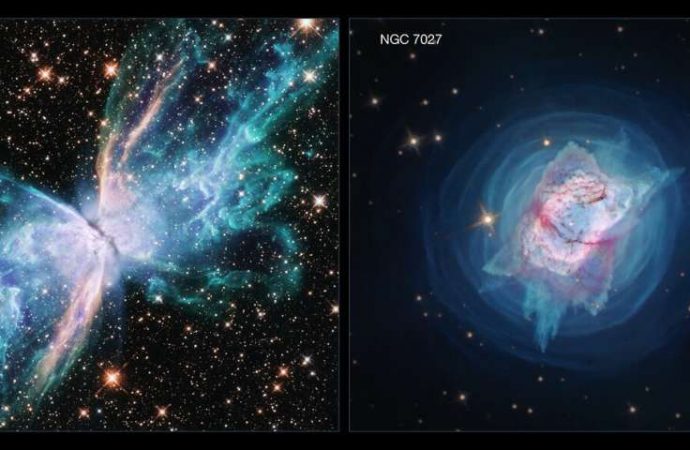Two stunning images captured by the Hubble Space Telescope show layers of gas and dust as they eject, swirl, and interact between two nebulas known as NGC 6302 and NGC 7027.
Source: IFL Science
It is the first time that astronomers have studied both nebulas using near-ultraviolet to near-infrared light, and was only made possible with the unique capabilities of the Hubble Space Telescope. The images can help researchers identify changes at the center of NGC 6302 – the Butterfly Nebular – and NGC 7027, or the “jewel bug”. The nebular duo has been photographed splitting apart on a short timescale – at least by space standards – of about 30 years, allowing researchers the ability to study them for decades.
Nicknamed for its wing-like appearance, the Butterfly Nebula has two S-shaped streams indicative of recent ejections that could be the result of two stars interacting at its core. The S-shape is only visible when capturing near-infrared emissions and is described as a “real eye-opener.” Butterfly Nebula is the counterpart to the jewel bug, both of which are some of the dustiest planetary nebulas known and contain large masses of gas.
The jewel bug nebula takes on a cloverleaf pattern from material shooting out in specific directions, which may also be the result of interactions between the two central stars. NASA notes that its appearance resembles an “insect with a brilliantly colored metallic shell.”
Because both are relatively new, the researchers say they are an interesting pair to study in conjunction with one another.
“When I looked in the Hubble archive and realized no one had observed these nebulas with Hubble’s Wide Field Camera 3 across its full wavelength range, I was floored,” said Joel Kastner, of Rochester Institute of Technology, New York, in a statement. “These new multi-wavelength Hubble observations provide the most comprehensive view to date of both of these spectacular nebulas. As I was downloading the resulting images, I felt like a kid in a candy store.”
Kastner describes several “aha” moments in his characterization of the nebula duo in a new study published in the journal Galaxies. The images show the nebulas splitting themselves apart, rapidly and quickly, which could be evidence of one-star merging with its companion.
“The nebula NGC 7027 shows emission at an incredibly large number of different wavelengths, each of which highlights not only a specific chemical element in the nebula but also the significant, ongoing changes in its structure,” said Kastner.
The analysis traces the history of each nebula’s shock waves, which are typically generated when space winds slam into gas, sweeping it and dust ejected from the star to create their tell-tale shape. It is thought that at the centers of both nebulas are two stars circling each other until they interact to produce a gas disk around one or both.
Source: IFL Science

































Leave a Comment
You must be logged in to post a comment.